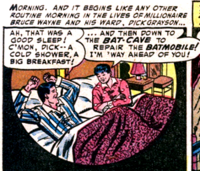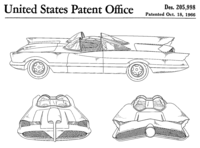There has been some controversy over various sexual interpretations made regarding the content of Batman comics. Homosexual interpretations have been part of the academic study of Batman since psychologist Fredric Wertham asserted in Seduction of the Innocent that "Batman stories are psychologically homosexual". He claimed, "The Batman type of story may stimulate children to homosexual fantasies, of the nature of which they may be unconscious". Wertham wrote, "Only someone ignorant of the fundamentals of psychiatry and of the psychopathology of sex can fail to realize a subtle atmosphere of homoeroticism which pervades the adventures of the mature 'Batman' and his young friend 'Robin'".
Andy Medhurst wrote in his essay "Batman, Deviance, and Camp" that Batman is interesting to gay audiences because "he was one of the first fictional characters to be attacked on the grounds of his presumed homosexuality," "the 1960s TV series remains a touchstone of camp," and " merits analysis as a notably successful construction of masculinity."
Creators associated with the character have expressed their own opinions. Writer Alan Grant has stated, "The Batman I wrote for 13 years isn't gay. Denny O'Neil's Batman, Marv Wolfman's Batman, everybody's Batman all the way back to Bob Kane... none of them wrote him as a gay character. Only Joel Schumacher might have had an opposing view". Writer Devin Grayson has commented, "It depends who you ask, doesn't it? Since you're asking me, I'll say no, I don't think he is ... I certainly understand the gay readings, though". While Frank Miller has described the relationship between Batman and the Joker as a "homophobic nightmare", he views the character as sublimating his sexual urges into crime fighting, concluding, "He'd be much healthier if he were gay". Burt Ward, who portrayed Robin in the 1960s television show, has also remarked upon this interpretation in his autobiography Boy Wonder: My Life in Tights; He writes that the relationship could be interpreted as a sexual one, with the show's double entendres and lavish camp also possibly offering ambiguous interpretation.
Such homosexual interpretations continue to attract attention. One notable example occurred in 2000, when DC Comics refused to allow permission for the reprinting of four panels (from Batman #79, 92, 105 and 139) to illustrate Christopher York's paper All in the Family: Homophobia and Batman Comics in the 1950s. Another happened in the summer of 2005, when painter Mark Chamberlain displayed a number of watercolors depicting both Batman and Robin in suggestive and sexually explicit poses. DC threatened both artist and the Kathleen Cullen Fine Arts gallery with legal action if they did not cease selling the works and demanded all remaining art, as well as any profits derived from them.

















